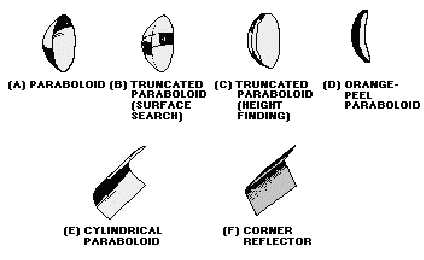3-19
Figure 3-19.—Reflector shapes.
The truncated paraboloid reflector may be used in height-finding systems if the reflector is rotated 90
degrees, as shown in view C. Because the reflector is now parabolic in the vertical plane, the energy is
focused into a narrow beam vertically. With the reflector truncated, or cut, so that it is shortened
horizontally, the beam spreads out horizontally instead of being focused. Such a fan-shaped beam is used
to determine elevation very accurately.
Orange-Peel Paraboloid
A section of a complete circular paraboloid, often called an ORANGE-PEEL REFLECTOR because
of its shape, is shown in view D of figure 3-19. Since the reflector is narrow in the horizontal plane and
wide in the vertical, it produces a beam that is wide in the horizontal plane and narrow in the vertical. In
shape, the beam resembles a huge beaver tail. This type of antenna system is generally used in height-
finding equipment.
Cylindrical Paraboloid
When a beam of radiated energy noticeably wider in one cross-sectional dimension than in the other
is desired, a cylindrical paraboloidal section approximating a rectangle can be used. View E of figure 3-19
illustrates this antenna. A parabolic cross section is in one dimension only; therefore, the reflector is
directive in one plane only. The cylindrical paraboloid reflector is either fed by a linear array of dipoles, a
slit in the side of a waveguide, or by a thin waveguide radiator. Rather than a single focal point, this type
of reflector has a series of focal points forming a straight line. Placing the radiator, or radiators, along this
focal line produces a directed beam of energy. As the width of the parabolic section is changed, different
beam shapes are obtained. This type of antenna system is used in search and in ground control approach
(gca) systems.
Q11. Which of the two general classes of antennas is most often used with radar?
Q12. The power gain of an antenna is directly related to what other antenna property?
Q13. A parabolic reflector changes a spherical wavefront to what type of wavefront?

